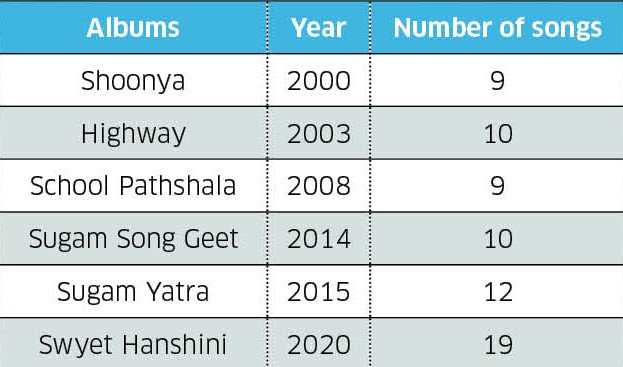Sugam Pokharel: The ideal Nepali pop culture Idol
Getting an offer for a seat at the Nepal Idol Season 4 judge panel was not a surprise for Sugam Pokharel. The Idol franchise had already approached him in the first season. “I could not work with them back then due to my busy schedule,” says Pokharel.
Yet Pokharel was a household name in Nepali music much before the start of Nepal Idol in 2017. If you grew up in the 2000s and loved music, his ‘Pheri Tyo Din Samjhana Chahanna’ must have been on your playlist. It was a hit from Shoonya, his debut album released in 2000 and the bestseller of that time. But the album’s evergreen songs didn’t come out of the blue.
“My first two songs were commercial failures,” he recalls. Back in 1995, he and Sudin Pokharel, aka DA69, had collaborated on a pair of songs: ‘Ma Maya Garchhu’ and ‘Payera Timilai Yesto Khusi Chhu’. This back-to-back failure made them part ways. Before the release of his solo album, Pokharel changed his stage name to 1MB, in what became a one-man band.
“I never regret those unsuccessful projects that laid the foundation of my musical career,” says Pokharel, a native of Biratnagar. After completing his SLC exams, he had come to Kathmandu with the primary goal of finishing higher studies and applying to go to the US. However, Pokharel ended up pursuing music. It was his elder brother Sunil Pokharel, a veteran theater artist, who helped him at the start of his musical career.
Also read: Namuna Giri: Born to be a poet
In 1997, the time between his failed songs and the first album, Pokharel started working as a librarian in Radio Sagarmatha. He then served as an RJ at the same station for 13 years. Even though he was already a pop star at the time, Pokharel says his association with the radio station changed him as a person, helping him become a better professional at a young age.
His second album, Highway, earned him more fame, with hits like ‘Maya Ko Bato’ and ‘Kati Din Bitey’. Soon, demands for his concert-appearances, from both in and outside the country, went through the roof. “I would perform at three different cities in a single day,” he recalls the days he would perform at Bhairahawa in the morning, Biratnagar in the afternoon, and Kathmandu in the evening. Swyet Hanshini, School Pathshala, Sugam Yatra, Sugam Song Geet, and Sutra are his other albums.
The year 2013, in a way, brought turbulence in his life when he was arrested for using drugs. But he was soon back on track. “In fact, the short break made me evaluate my career and the love of my fans anew,” he says.

Pokharel had even worked in a tele-serial named ‘Lachhamaniya’ when he was in the seventh grade but had given up on his childhood dream of becoming a movie superstar because of the hassles with retakes. “But I fulfilled my dream to an extent by modeling in my music videos,” he says with a laugh. Besides singles and albums, Pokharel has recorded numerous hits as a playback singer, demonstrating his all-round skills.
These days, he is busy with shows, concerts, and of course, Nepal Idol. “I am enjoying the shoots as our team has good coordination,” he shares the new experience of being in an international franchise show. A long time back, he was also a judge in a reality show called Singing Stars. “I love this platform that helps both the judges and the contestants learn and grow together,” he adds.
Besides Nepal Idol, Pokharel is working on his upcoming album Tilasmi Kathmandu. He says the album will be a tribute to Kathmandu city, which gave him all the things he wanted in his career. He wants to connect with each and every resident of Kathmandu and is currently working on the album’s last song in which he will be using the Newari language.
Pokharel is upbeat about the future of the Nepali music industry. However, he laments some people’s obsession with fame, which will take them nowhere. “To be a successful singer, you just have to practice hard and respect the seniors,” he says.
Namuna Giri: Born to be a poet
You must have noticed Namuna Giri stopping by your Instagram feed once in a while, her heartwarming poetry videos with calming music at once grabbing your attention. In fact, the now 22-year-old had fallen in love with writing with her thoughts at a young age.
Growing up, Giri and her family moved around a lot and she never found herself getting attached to a place. Yet, she says, she carries in herself every place she has lived in.
Over the years, on the outside, she taught herself to express only the good and obedient side of her. “I tried my best not to let people around me know if I am sad or angry,” she shares with ApEx. “That way, I bottled up a lot of emotions.”
Again, writing was one thing that naturally came to her. Her friends and teachers noticed early that she had a knack for framing her words. “I never intended to write poems, yet somehow my writing turned out to be poetic,” she says with a bright smile. “I wouldn’t even realize my words rhymed.”
But Giri was not the kind of person who would naturally jot down her thoughts. Instead, she found comfort in talking to herself without even realizing it, and sharing whatever she thought as though she were writing with her own thoughts. She figured she could make sense out of this side of her by making videos of herself speaking out loud. “I made a record, and the words started flowing like magic,” says Giri. From then, she started uploading short 15-second videos on her Instagram to her small group of followers.
At the same time, she had just finished her plus-two and had to decide what she wanted to pursue as a career. As a student of science, medical school was her first choice. But then she would spend more time lost in the ocean of novels rather than studying her course-books. She had a rethink.
As a lover of words, she dove right into every storyline she read. Coincidentally, nearly every protagonist of the books she read was a lawyer. “I took it as a sign and decided to also apply to a law school after researching some more,” she shares. “Strangely enough, it turned out to be the right subject for me, like it was meant to be”.
Giri is currently doing her BA LLB from National Law College. Meanwhile, she has been making short poetry and storytelling videos of her writings on social media—her Insta fan-base has now grown to over 17,000 followers. She also shares her poetry and snippets of her life on her YouTube channel.
Giri finds inspiration in the people she encounters. All her life, she has been fascinated by little things happening around her. “When I’m walking on the street and I see someone, I can’t help but wonder about their life,” she says, her eyes lighting up. “I imagine myself in their shoes and try to channel their emotions through writing. That's how most of my poems come to life.”
Looking back, the little Namuna never thought sharing poetry on Instagram would take her anywhere. Yet she says that a part of her always knew. Poetry has helped her make sense of and understand herself better.
In the beginning, she wasn’t as confident as she is today. With the comments, criticisms, and judgments her words brought along with the growing number of views, there were times she didn’t feel good enough to do it.
Also read: Biswas Timshina: Bye-bye engineering, hellow stand-up
An overload of assumptions, expectations, and criticism dissuaded her. It was hard to come to terms with the things said about her words, and about the way she spoke. Once, she was so daunted she stopped posting. “The most challenging part of showing the raw and emotional side of me on social media was finding a space to fit in all the negatives with the positives,” she shares. With time, though, Giri has learned that when it comes to poetry, she needs to listen to her own criticism.
She is at her happiest when she speaks to the camera about her thoughts, edits the shots, adds right music, and posts. It all seems effortless, and she plans on doing it for as long as she can.
Pursuing a career in law and writing poetry, Giri feels she has found the perfect combination to balance her real-world responsibilities and the endless world of her imagination. “I want to prosper academically, putting in all that it takes,” she says. “And I trust that poetry is something that can never be taken away from me”.
Giri also aims to write a book one day. “There is not much I can fit in one-to-four minute videos when I have so much to share,” she says. “I want to build a path through my book and explore where it takes me.”
Pratap KC: Prominent persona of Nepali music
Over time, Pratap KC, born in Janakpur, has established himself as a well-known flute artist of Nepal. He has been dedicated to learning music since he was a toddler.
KC has worked with many renowned bands like ‘Rock Sitar’, led by the late Bijaya Vaidya. He now is the key man of Prana Mundi—a prominent folk fusion band—well-known for his diverse set of playing abilities.
He has also helped in the tourism field with his flutes as he brought Nepali folk to Europe and other parts of the world, promoting Nepali music. KC has performed on numerous major international stages and has accomplished his objectives of the musical journey. With his musical prowess, he also assisted 2015 earthquake victims by putting on a spectacle with many Bollywood stars to raise the fund.
KC is an inspiration to young music aspirants, as his priority relies on practicing fusion with young artists.
Biswas Timshina: Bye-bye engineering, hellow stand-up
Biswas Timshina set a safe and straight career path for himself early in his childhood: finish school, study engineering, graduate, land a decent job and build a family home.
When he finished school, he started studying engineering as well, hoping to follow through on his plan. But the plan quickly began to unravel.
Born in Gangtok, Sikkim, Timshina grew up in a joyful and loud Nepali-speaking household. “If any teacher asked who tells the best jokes in my class, I would be the one everyone would point to,” says Timshina. “At home too, I was the one to crack jokes.”
In his first year of college, Timshina found himself more involved in writing scripts for mini-college documentaries rather than meeting assignment-deadlines. “I was enjoying the entire process of writing scripts, capturing videos, and putting them all together,” he shares. By the time he reached his final year, he realized he wanted to work with cameras and comedy rather than computers and calculators.
“My joyful and loud upbringing must be the source of my love for making people laugh,” shares Timshina, now popular in the Nepali-speaking world as BT Kancha.
His YouTube channel with the same name now has 170,000 subscribers, most of them from Nepal. Timshina, who has consistently been posting videos since 2017, explores ideas that resonate with Nepali-speaking communities around the world. Starting with parodies, some of which reached more than two million views, he moved to funny film reviews and even stand-up comedy.
Regardless of the genre, the foundation of his creative process lies in writing. “Everything starts with a blank piece of paper, and then comes the creative process of channeling the voice inside me,” he shares. “I think that’s what inspires me to create something on my terms.”
Offline, he started by performing stand-up comedy at open mics in Mumbai and, later in 2018, at home in Sikkim. In his journey as a stand-up, from one stage to the other, he taught himself to adapt and improve and hone his craft. He fell in love with the uncertainty: would people laugh at his jokes? He found the entire process of writing, practicing and performing both challenging and exciting.
Also read: Shilpa Maskey: Dancing out her dream
Timishina decided to make videos in Nepali as it was the language that felt most natural. “Making funny videos in Hindi would have helped me grow my fanbase and number of views much faster,” he confesses. “But I never wanted to chase fame, I just wanted to make people laugh in my way, in the language I connect to the most.”
He posts two videos a month on his YouTube channel, taking around 10 days for the production. Alongside, he is also doing screenplays by writing scripts for different movies—he co-wrote the script for the Priyanka Chopra-produced Nepali movie ‘Pahuna’.
He also recently performed his first stand-up comedy show in Kathmandu, overwhelming the organizers who had expected around 20 people but had to accommodate over 200. Most of them were seated for the entire event as his was the final act of the night.
Timshina now plans to continue writing screenplays and posting funny review videos on his channel. He is also working on a mini-series and looking for sponsors.
For him, the most challenging part of writing scripts is coming up with an idea that clicks with him and his audiences. Writing screenplays, producing YouTube videos and performing stand-up become a hassle at times, but as all three involve pen and paper, he enjoys himself doing what he does best.
The little boy who once had his entire life planned out is now on unchartered territory, without a safety net. “Funnily, even after completing my degree, I never actually went to college to get that certificate,” he laughs. “I had come to know that engineering is not something I wanted to do in life, and when choosing film-making, I wanted to give it my all with no safety net to fall back to,” says Timshina.
Having no backup plans and deadlines make him remember why he decided to take the untrodden path: to have fun and enjoy the process





















